| Author | Message | ||
| edwardofhuncote
Senior Member Username: edwardofhuncote Post Number: 412 Registered: 6-2014 |
Wow, time is flying by... I've been so busy trying to catch up on promised work and paying jobs in the shop that I really haven't had time to spend on my own projects. Anyway, my Shop Thread got archived since the last installment back in March, so here's a link back to the first page: http://alembic.com/club/messages/449/207566.html?1427122697 I've got a little more free time in the evenings now, so I'll try to pick this up again. When we left off, I had finished with preparing the neck for 5-string conversion and laid it aside. The old chunky body has now been dissected into just what will become the core of the future body wings. Using discarded chunks from the trim, I have plugged the old pickup routs. Each half will be planed, then thickness-sanded down to 3/4" thick, taking out several old screw holes and most of the old pickup routs, after which each half will get curly/quilted maple top and back laminates 1/4" thick. The control cavity will be enlarged as well, to allow for more room. (I'm not 100% sure yet, but planning to incorporate magnetic and piezo blending electronics.) At the moment, I'm planning the finished thickness of the body to be about 1-1/8", and with slight ergonomic contours, but I'm not going to bevel the edges much more than just taking off the corner. (Think - Rickenbacker but without binding) So, here's a couple pictures of the body-to-be. 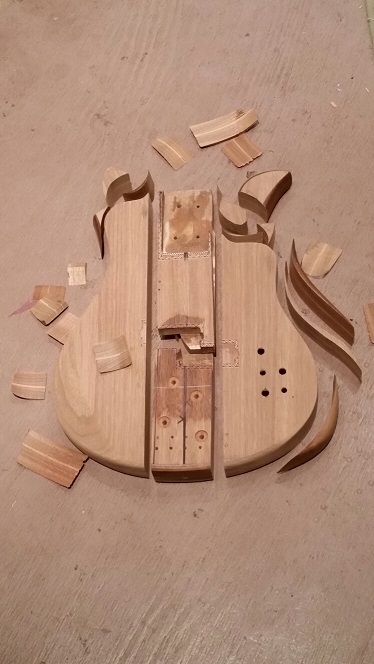 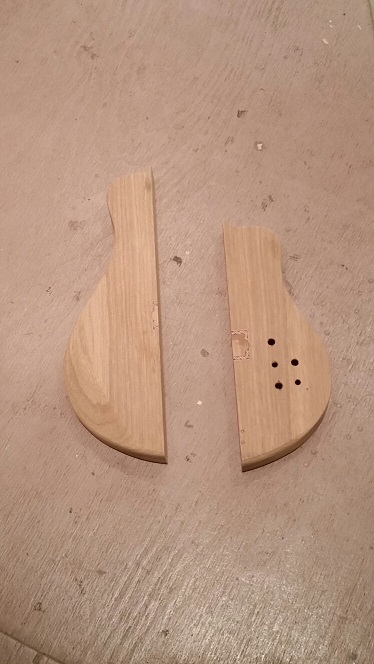 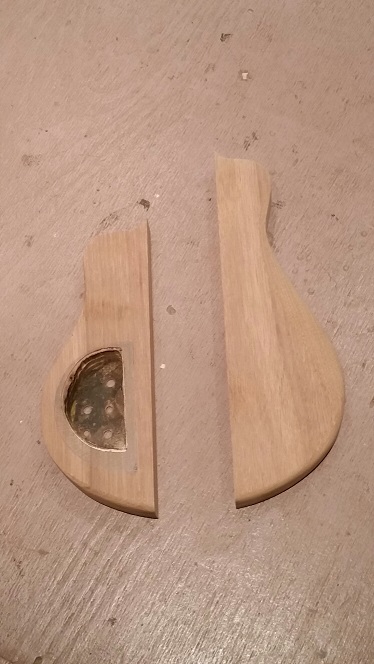 The core center is a bit of a surprise, and that'll probably be the next major installment... stay tuned. *Hint - though unmentioned, it's partially visible in the pictures within the first thread. =) (Message edited by edwardofhuncote on June 23, 2015) | ||
| edwardofhuncote
Senior Member Username: edwardofhuncote Post Number: 417 Registered: 6-2014 |
While the 5-string conversion project is hold until I get the shop cleared out some more, I thought maybe I would expand on the background... So if you hear banjo music, PADDLE FASTER! I've posted before about how I learned to work on musical instruments from my Dad, who in addition to other odd instrument repair work, also built banjos. It was always (and still is) just a hobby to both of us, but that's really where I got the start from. There was a time when I thought it was what I wanted to do... fortunately for me, the career path of a luthier just didn't work out. Anyway, just in passing, I ran across this one the other day, hadn't seen it in a long time, and it made me think about how many others were still out there, and how many could be accounted for. It's banjo #9622, meaning we built it in 1996, and it was 22nd in sequence. Out of 30 made, I know where about 20 of them are now... the story starts when I was just a 13 year-old kid.     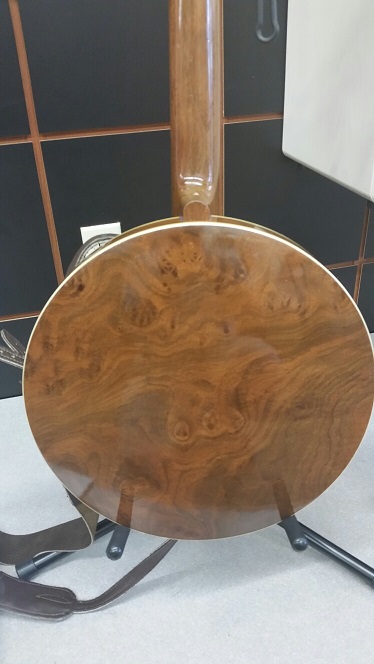   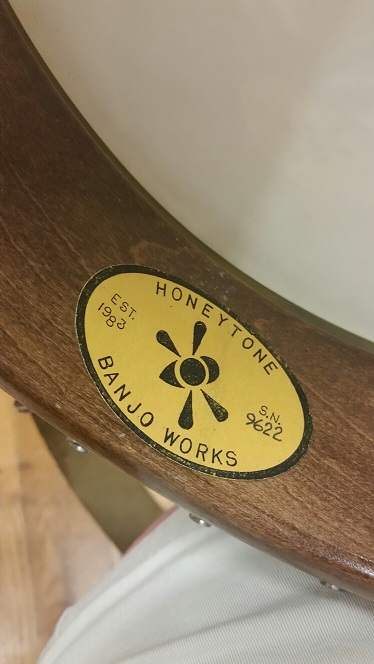 | ||
| edwardofhuncote
Senior Member Username: edwardofhuncote Post Number: 418 Registered: 6-2014 |
So beginning in 1983, Dad turned out the first few instruments... rather than "from scratch" they were partial or sometimes total rebuilds of 1970's era Gibsons (which weren't all that stellar to start with) or Stellings, which were okay, but heavier than a pail of nails. We were modding and customizing these things strictly on a one-at-a-time basis... mostly just for local players or friends. In this part of the world, shake any good-sized tree and a half-dozen banjo players will tumble out... at least a couple of them will br really good ones. Among them, Dad was good at the technical and structural details, and his setup work was known far and wide as the best around. Early on he saw I had a better eye for the artistic aspects, later I would learn to do all his finish and detail work. By the time 1987 rolled around, we had begun putting our own brand name on the banjos, beginning with instrument #8, which was commissioned by a friend of ours who was (and still is) a touring musician. He wanted all gold-plated hardware, a drastically radiused fingerboard and a fully carved resonator, and only gave us a rough sketch to go on for appointments. This was the first banjo to ever have the trademark "honeybee" logo. The name "Honeytone" started as an inside joke, but just kinda' stuck. Though old #8 changed hands and then dropped out of sight following a bad divorce, he still has another of our banjos, #19, which has it's own great story... it was backpacked to the summit of Mount Fuji once during a tour stop in Japan. The monks who live there, never having seen such a thing were so fascinated they burned a seal into the back of it. At least that's how the story went! The next big step came in 1991, when #16 was ordered. "Sweet Sixteen" was to be a birthday present for a really gifted girl who had a very bad back injury. Her parents needed to find her a lightweight banjo, but one that was still professional grade, so Dad went to work and totally redesigned everything. Rather than a heavy bell brass tone ring, we settled on a simple 11" diameter brass hoop, made of 1/4" stock, reminiscent of Gibson's lowend models from the 1920's. The shell (round part) was also redesigned so that the lathe tapered to a peak at the top. Though a lightweight banjo that still sounded and played good flew in the face of tradition, it was a perfect combination tone-wise, and with the lightened shell, we had shaved almost 5 pounds off the total weight. She loved it, and still plays it to this day. I just replaced the original pegs last year, worn slap out. About the same time we started on #16, I had taken some of Dad's doodles, and come up with a unique headstock pattern which was completely asymmetrical (also a big no-no to traditional banjo guys) but loosely resembling a 100 year old headstock he had seen somewhere. The first guy that came into our shop and saw #16's neck in the bench-vise was so impressed with the radical new, old-school peghead that he ordered #17 right on the spot. Every banjo since then (except #18, which was already in progress) has that same pattern. I still have the original plexiglass template hanging over my bench. In the mid-1990's, based on how well his new design had worked out, after some more tweaking, Dad decided to build a set of 3 banjos, that would all share this new lightweight pot assembly design, but be completely different in what wood we used, and how they were appointed. He put me in charge of that part, and we started work on #22, 23, & 24. It was the first time I remember us building something without a specific customer in mind. All three were sold within a month, #24 went to New England and eventually went home to Europe with it's original owner, #23 went to western North Carolina, and a guy who owned a local music store bought #22, and still has it today. It's been refretted twice, and had to be repaired one time after a gig bag... incident. (this is the abalone-inlaid burled walnut one in the pictures) After building 30 banjos, 3 guitars, a couple mandolins, and who knows how many repairs in between, these days we don't do as much... all the tools are in my shop now (I mostly work on upright basses) but in the past 10 years between his job and mine there just hasn't been enough time. Dad's looking at retirement, possibly as soon as this fall, and there's already rumors and rumbles about us cranking up production again... #31-35 are packed away waiting. | ||
| edwardofhuncote
Senior Member Username: edwardofhuncote Post Number: 419 Registered: 6-2014 |
Here's a tragic story that happened to one of our banjos... this was #9320. 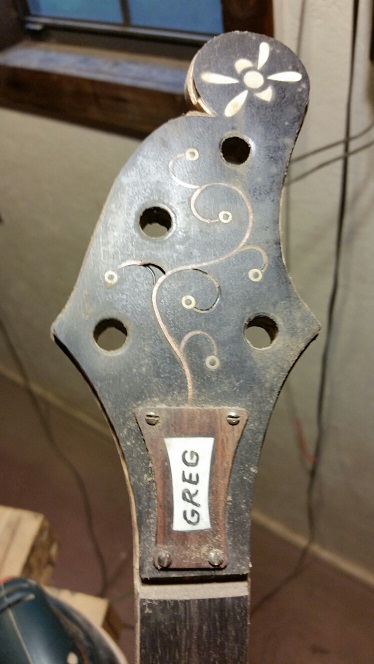   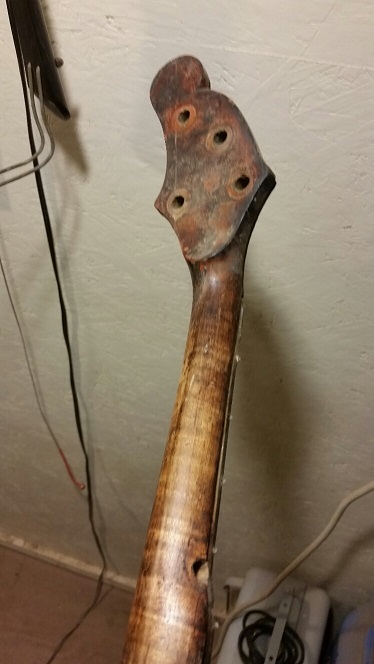 She was lost to a house fire, cut down too early in life. It had an open-back Vega "Whyte Laydie" style pot assembly, and a curly maple neck, with copper wire inlay. (I was apparently fascinated with torches and vases at the time) In addition to the wire, it's inlaid with rosewood, ivory from salvaged piano keys, and even the brass ball-ends from guitar strings. The base of the vase had a "XX" inlaid into it too. Sadly it was a total loss... the insurance covered the loss, and the guy who had owned #20 bought another banjo. Somebody saw the remains at a sale, and saved them for me. It hangs in my shop as a souvenir now. (Message edited by edwardofhuncote on June 29, 2015) | ||
| davehouck
Moderator Username: davehouck Post Number: 11821 Registered: 5-2002 |
Thanks for sharing these stories! | ||
| peoplechipper
Senior Member Username: peoplechipper Post Number: 608 Registered: 2-2009 |
Wow, that's nice work and I really like that headstock...you and your Dad are on to something good...funny how some things are obviously hard to do and anyone can see it, like good inlay work, and some stuff you just can't tell like some of the jewellery work I do; sometimes people can tell it's complex, but sometimes I'm like "you have NO IDEA how hard this is to do!" but it looks simple to the layperson...Tony. |